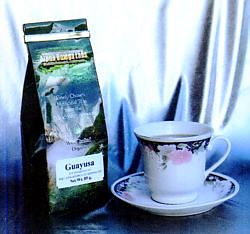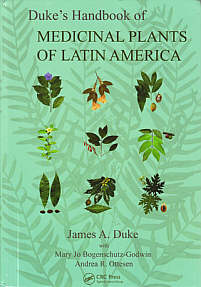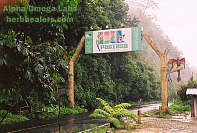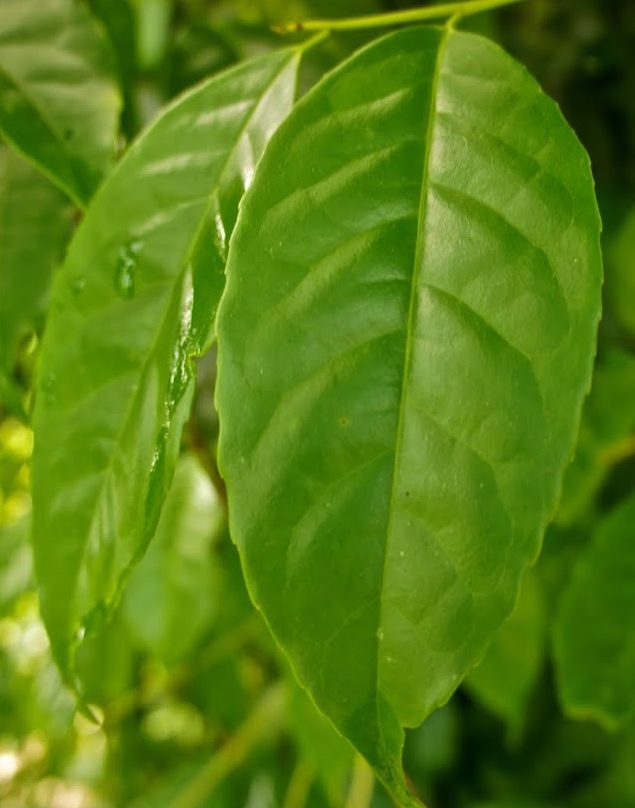|
Morning Stimulant & Coffee Substitute

Guayusa
( Ilex guayusa Loes. )
Dried Leaf of Guayusa
Code 323 -- Price: $4.95
Tea Leaves: 85 gr. (net wt)
Makes 4 Gallons of Tea
(Using 20 g. or 5 T.
to make one gallon)
Code 323C -- Price: $18.95
120 Capsules x 500 mg.
Order Now
 Email
Email
 Summarized Description:
Guayusa Summarized Description:
Guayusa is one of our
traditionals.
It is widely used in the Amazonian region of Ecuador and Peru as a morning
stimulant. I have spoken to several shamans who have elderly members
of their communities that attribute their longevity to drinking
guayusa every morning. Though this view is widely held, I can find
nothing in the extant, scientific literature to support it.
Speaking more personally, I have notice in my own use of it,
that I feel more wide awake and clear-headed.
 Naysayers will point to the
fact that the dried leaves in this product contain 31,000 ppm
of caffeine. (1) However, I believe that not enough research has
been done to truly know what the source of its reported properties are.
 uayusa
is widely used traditional from the Amazon,
used primarily as an early morning beverage. uayusa
is widely used traditional from the Amazon,
used primarily as an early morning beverage.
Use & Protocol
 I. Preparation --- if you can boil water, you
can make this product: Professional herbalists will
recognize this as a standard decoction. I. Preparation --- if you can boil water, you
can make this product: Professional herbalists will
recognize this as a standard decoction.
- Add roughly 20 grams or about 5 Tablespoons to
one gallon of purified water (or proration thereof). Boil for 45 minutes.
- It is traditional to drink a cup of this product in the morning
before beginning the day's activities.
Warnings / Contraindications
 Duke notes that as of July, 2007,
the FDA Poisonous Plant Database listed one title alluding to toxicity of
this species. (2) (I have met people over the page of 100 in the Amazon who
have consumed guayusa tea all of their lives. You would never convince
native Amazonian people that guayusa is toxic.) Duke notes that as of July, 2007,
the FDA Poisonous Plant Database listed one title alluding to toxicity of
this species. (2) (I have met people over the page of 100 in the Amazon who
have consumed guayusa tea all of their lives. You would never convince
native Amazonian people that guayusa is toxic.)
Shelf-Life
 This product is dehydrated, so its
functional shelf-life is well in excess of two years. This product is dehydrated, so its
functional shelf-life is well in excess of two years.

Medicinal Activities
 Further information for practitioners:
World-famous botanist Dr. James Duke attributes the following activities
to this plant (p. 369; see hardcopy cover at right),
drawn from the extant literature. (See his graduation for "level of
efficacy" on our amazon traditionals page;
followed by Duke's bibliographic abbreviations (in capital letters),
which we identify
on a separate page.) Further information for practitioners:
World-famous botanist Dr. James Duke attributes the following activities
to this plant (p. 369; see hardcopy cover at right),
drawn from the extant literature. (See his graduation for "level of
efficacy" on our amazon traditionals page;
followed by Duke's bibliographic abbreviations (in capital letters),
which we identify
on a separate page.)
- Antidiabetic (1; X2743711);
- Antiseptic (f; DAV);
- Antisterility (f; EGG);
- Antivenereal (f; EGG);
- Aphrodisiac (f; SAR);
- Cholagogue (f; DAV);
- Diaphoretic (f; MPG);
- Digestive (f; MPG);
- Diuretic (f; MPG);
- Emetic (f; EGG; MPG; RAR);
- Expectorant (f; MPG);
- Febrifuge (f; EGG);
- Hallucinogenic (f; MPG);
- Hypnotic (f; MPG);
- Hypoglycemic (f; MPG);
- Laxative (f; MPG);
- Narcotic (f; EGG; MPG);
- Purgative (f; MPG; RAR);
- Sedative (f; SAR);
- Stimulant (f; EGG; SAR; X7736849);
- Stomachic (f; MPG);
- Tonic (f; EGG; MPG).
Indications
 Further information for practitioners:
Duke provides the following indications for this plant: Further information for practitioners:
Duke provides the following indications for this plant:
- Catarrh (f; MPG);
- Childbirth (f; SAR);
- Constipation (f; MPG);
- Diabetes (f1; MPG; X2743711);
- Dysmenorrhea (f; MPG; SAR);
- Enterosis (f; MPG);
- Fever (f; EGG; SAR);
- Flu (f; MPG);
- Gastrosis (f; SAR);
- Hangover (f; SAR);
- Hepatosis (f; SAR);
- Impotence (f; SAR);
- Infection (f; DAV);
- Insomnia (f; SAR);
- Malaria (f; SAR);
- Nervousness (f; SAR);
- Pain (f; SAR);
- Rheumatism (f; DAV);
- Sterility (f; EGG; MPG);
- Stomachache (f; SAR);
- Syphilis (f; SAR);
- VD (f; EGG; SAR).
Footnotes
- Duke, James A., Medicinal Plants of Latin America, CRC Press, 2009, p. 369.
- Ibid.
- Ibid.
|
 To U.S. Users: To U.S. Users: This product
have not been evaluated by the U.S. Food & Drug Administration.
It is not intended to diagnose, treat, cure, or prevent any disease.
|
 Sourcing From
Sourcing From
The Amazon
 All the materials used to
make our Ajo Té are wild-crafted and harvested
from deep in the the provinces of Pastaza and Moreno Santiago, near the
Peruvian border. There are no cultivated varieties.
Click photo to enlarge.
Dosages &
Ethnobotanical
Usage
 Duke provides a "food pharmacy
potential" score for this plant of, "FNFF=!" ("Survival food . . .
questionable"). "Leaves locally consumed in stimulant beverages (JAD).
Decoction of 4-5 leaves in a liter of water drunk for diabetes." (MPG)(3)
- Amazonian Ecuadorians and Peruvians take the tea as a morning
stimulant (X1682531).
- Bolivians and Peruvians use the plant as a ritual hallucinogen (MPG).
- Jibaro consider the leaves emetic, hypnotic, narcotic, and purgative. (MPG)
- Peruvians take leaf tea as antisterility, antivenereal, emetic, febrifuge,
stimulant, and tonic, a stronger tea as narcotic (EGG).
|




